Sarilumab
Editor-In-Chief: C. Michael Gibson, M.S., M.D. [1]; Associate Editor(s)-in-Chief: Yashasvi Aryaputra[2];
Disclaimer
WikiDoc MAKES NO GUARANTEE OF VALIDITY. WikiDoc is not a professional health care provider, nor is it a suitable replacement for a licensed healthcare provider. WikiDoc is intended to be an educational tool, not a tool for any form of healthcare delivery. The educational content on WikiDoc drug pages is based upon the FDA package insert, National Library of Medicine content and practice guidelines / consensus statements. WikiDoc does not promote the administration of any medication or device that is not consistent with its labeling. Please read our full disclaimer here.
Black Box Warning
|
RISK OF SERIOUS INFECTIONS
See full prescribing information for complete Boxed Warning.
|
Overview
Sarilumab is a interleukin-6 (IL-6) receptor antagonist that is FDA approved for the treatment of adult patients with moderately to severely active rheumatoid arthritis who have had an inadequate response or intolerance to one or more disease-modifying antirheumatic drugs (DMARDs). There is a Black Box Warning for this drug as shown here. Common adverse reactions include neutropenia, increased ALT, injection site erythema, upper respiratory infections and urinary tract infections.
Adult Indications and Dosage
FDA-Labeled Indications and Dosage (Adult)
Indications:
- Sarilumab is indicated for treatment of adult patients with moderately to severely active rheumatoid arthritis (RA) who have had an inadequate response or intolerance to one or more disease-modifying antirheumatic drugs (DMARDs).
Recommended Dosage:
- Sarilumab may be used as monotherapy or in combination with methotrexate (MTX) or other conventional DMARDs.
- The recommended dosage of Sarilumab is 200 mg once every two weeks given as a subcutaneous injection.
- Reduce dose to 150 mg once every two weeks for management of neutropenia, thrombocytopenia and elevated liver enzymes.
Dosage Modifications for Laboratory Abnormalities or Serious Infection
- If a patient develops a serious infection, hold treatment with Sarilumab until the infection is controlled.
- Modify dosage in case of neutropenia, thrombocytopenia or liver enzyme elevations (see TABLE 1).
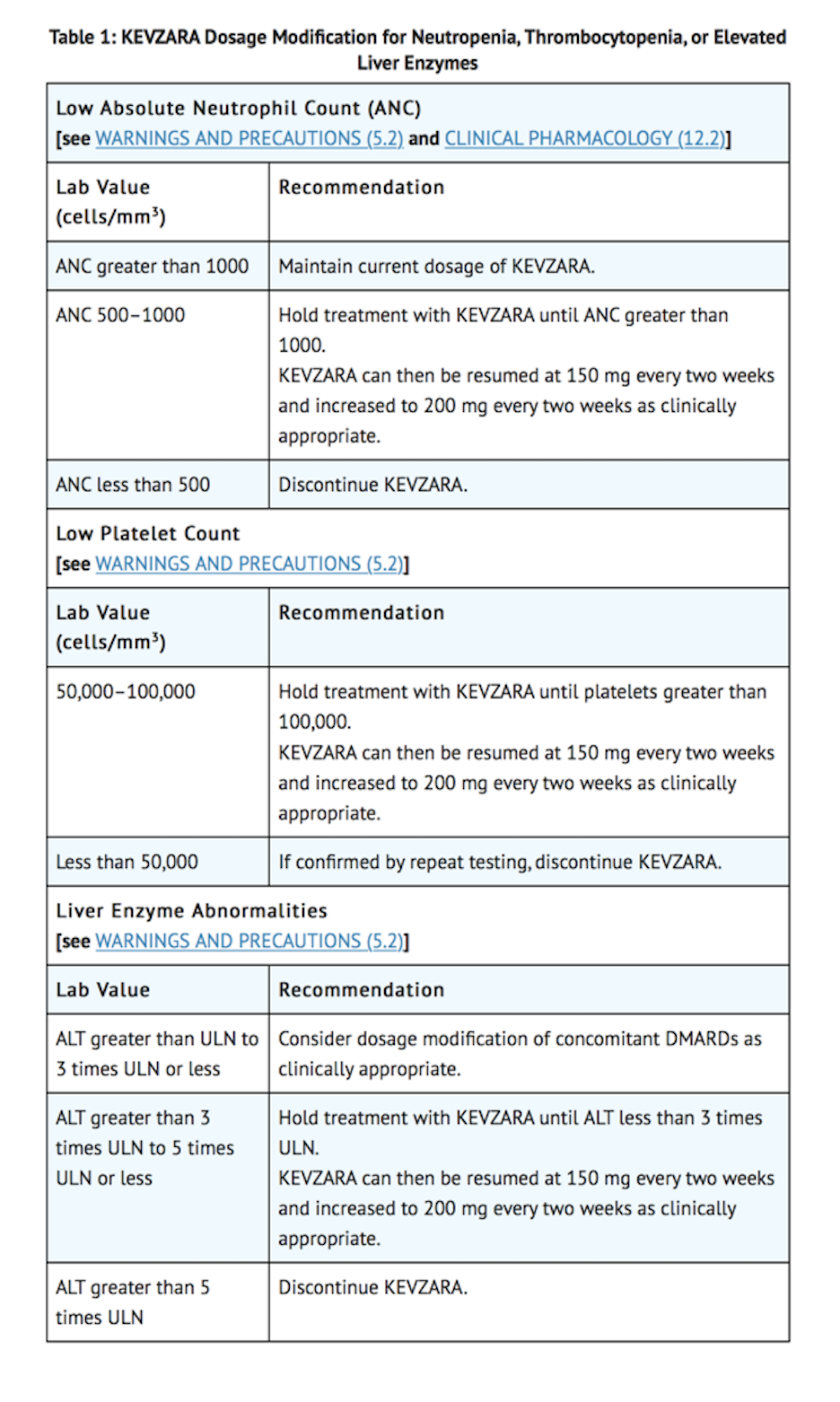
Off-Label Use and Dosage (Adult)
Guideline-Supported Use
There is limited information regarding Sarilumab Off-Label Guideline-Supported Use and Dosage (Adult) in the drug label.
Non–Guideline-Supported Use
There is limited information regarding Sarilumab Off-Label Non-Guideline-Supported Use and Dosage (Adult) in the drug label.
Pediatric Indications and Dosage
FDA-Labeled Indications and Dosage (Pediatric)
There is limited information regarding Sarilumab FDA-Labeled Indications and Dosage (Pediatric) in the drug label.
Off-Label Use and Dosage (Pediatric)
Guideline-Supported Use
There is limited information regarding Sarilumab Off-Label Guideline-Supported Use and Dosage (Pediatric) in the drug label.
Non–Guideline-Supported Use
There is limited information regarding Sarilumab Off-Label Non-Guideline-Supported Use and Dosage (Pediatric) in the drug label.
Contraindications
- Sarilumab is contraindicated in patients with known hypersensitivity to Sarilumab or any of the inactive ingredients.
Warnings
|
RISK OF SERIOUS INFECTIONS
See full prescribing information for complete Boxed Warning.
|
Serious Infections
- Serious and sometimes fatal infections due to bacterial, mycobacterial, invasive fungal, viral, or other opportunistic pathogens have been reported in patients receiving immunosuppressive agents including Sarilumab for rheumatoid arthritis (RA). The most frequently observed serious infections with Sarilumab included pneumonia and cellulitis. Among opportunistic infections, tuberculosis, candidiasis, and pneumocystis were reported with Sarilumab. Some patients presented with disseminated rather than localized disease and were often taking concomitant immunosuppressants such as methotrexate or corticosteroids, which in addition to RA may predispose them to infections. While not reported in Sarilumab clinical studies, other serious infections (e.g., histoplasmosis, cryptococcus, aspergillosis) have been reported in patients receiving other immunosuppressive agents for the treatment of RA.
- Avoid use of Sarilumab in patients with an active infection, including localized infections. Consider the risks and benefits of treatment prior to initiating Sarilumab in patients who have:
- chronic or recurrent infection;
- a history of serious or opportunistic infections;
- underlying conditions, in addition to RA, that may predispose them to infection;
- been exposed to tuberculosis; or
- lived in or traveled to areas of endemic tuberculosis or endemic mycoses.
- Closely monitor patients for the development of signs and symptoms of infection during treatment with Sarilumab, as signs and symptoms of acute inflammation may be lessened due to suppression of the acute phase reactants.
- Hold treatment with Sarilumab if a patient develops a serious infection or an opportunistic infection.
- Perform prompt and complete diagnostic testing appropriate for an immunocompromised patient who develops a new infection during treatment with Sarilumab; initiate appropriate antimicrobial therapy, and closely monitor the patient.
Tuberculosis
- Evaluate patients for tuberculosis (TB) risk factors and test for latent infection prior to initiating treatment with Sarilumab. Treat patients with latent TB with standard antimycobacterial therapy before initiating Sarilumab. Consider anti-TB therapy prior to initiation of Sarilumab in patients with a past history of latent or active TB in whom an adequate course of treatment cannot be confirmed, and for patients with a negative test for latent TB but having risk factors for TB infection. When considering anti-TB therapy, consultation with a physician with expertise in TB may be appropriate.
- Closely monitor patients for the development of signs and symptoms of TB including patients who tested negative for latent TB infection prior to initiating therapy.
Viral Reactivation
- Viral reactivation has been reported with immunosuppressive biologic therapies. Cases of herpes zoster were observed in clinical studies with Sarilumab. The risk of Hepatitis B reactivation with Sarilumab is unknown since patients who were at risk for reactivation were excluded.
Laboratory Abnormalities
Neutropenia
- Treatment with Sarilumab was associated with a higher incidence of decrease in absolute neutrophil count (ANC), including neutropenia.
- Assess neutrophil count prior to initiation of Sarilumab and monitor neutrophil count 4 to 8 weeks after start of therapy and every 3 months thereafter.
- Based on the pharmacodynamics of the changes in ANC, use results obtained at the end of the dosing interval when considering dose modification.
Thrombocytopenia
- Treatment with Sarilumab was associated with a reduction in platelet counts in clinical studies.
- Assess platelet count prior to initiation of Sarilumab and monitor platelets 4 to 8 weeks after start of therapy and every 3 months thereafter.
Elevated Liver Enzymes
- Treatment with Sarilumab was associated with a higher incidence of transaminase elevations. These elevations were transient and did not result in any clinically evident hepatic injury in clinical studies. Increased frequency and magnitude of these elevations were observed when potentially hepatotoxic drugs (e.g., MTX) were used in combination with Sarilumab.
- Assess ALT/AST levels prior to initiation of Sarilumab and monitor ALT and AST levels 4 to 8 weeks after start of therapy and every 3 months thereafter. When clinically indicated, consider other liver function tests such as bilirubin.
Lipid Abnormalities
- Treatment with Sarilumab was associated with increases in lipid parameters such as LDL cholesterol, HDL cholesterol and/or triglycerides.
- Assess lipid parameters approximately 4 to 8 weeks following initiation of treatment with Sarilumab, then at approximately 6 month intervals.
- Manage patients according to clinical guidelines for the management of hyperlipidemia.
Gastrointestinal Perforation
- Gastrointestinal perforations have been reported in clinical studies, primarily as complications of diverticulitis. GI perforation risk may be increased with concurrent diverticulitis or concomitant use of NSAIDs or corticosteroids. Promptly evaluate patients presenting with new onset abdominal symptoms.
Immunosuppression
- Treatment with immunosuppressants may result in an increased risk of malignancies. The impact of treatment with Sarilumab on the development of malignancies is not known but malignancies were reported in clinical studies.
Hypersensitivity Reactions
- Hypersensitivity reactions have been reported in association with Sarilumab. Hypersensitivity reactions that required treatment discontinuation were reported in 0.3% of patients in controlled RA trials. Injection site rash, rash, and urticaria were the most frequent hypersensitivity reactions. Advise patients to seek immediate medical attention if they experience any symptoms of a hypersensitivity reaction. If anaphylaxis or other hypersensitivity reaction occurs, stop administration of Sarilumab immediately. Do not administer Sarilumab to patients with known hypersensitivity to Sarilumab.
Active Hepatic Disease and Hepatic Impairment
- Treatment with Sarilumab is not recommended in patients with active hepatic disease or hepatic impairment, as treatment with Sarilumab was associated with transaminase elevations.
Live Vaccines
- Avoid concurrent use of live vaccines during treatment with Sarilumab due to potentially increased risk of infections; clinical safety of live vaccines during Sarilumab treatment has not been established. No data are available on the secondary transmission of infection from persons receiving live vaccines to patients receiving Sarilumab. The interval between live vaccinations and initiation of Sarilumab therapy should be in accordance with current vaccination guidelines regarding immunosuppressive agents.
Adverse Reactions
Clinical Trials Experience
- Because clinical studies are conducted under widely varying conditions, adverse reaction rates observed in the clinical studies of a drug cannot be directly compared to rates in the clinical studies of another drug and may not reflect the rates observed in practice.
- All patients in the safety data described below had moderately to severely active rheumatoid arthritis.
- The safety of Sarilumab in combination with conventional DMARDs was evaluated based on data from seven studies, of which two were placebo-controlled, consisting of 2887 patients (long-term safety population). Of these, 2170 patients received Sarilumab for at least 24 weeks, 1546 for at least 48 weeks, 1020 for at least 96 weeks, and 624 for at least 144 weeks.
- The pre-rescue placebo-controlled population includes patients from the two Phase 3 efficacy studies (Studies 1 and 2) from weeks 0 to 16 for Study 1 and weeks 0 to 12 for Study 2, and was used to assess common adverse reactions and laboratory abnormalities prior to patients being permitted to switch from placebo to Sarilumab. In this population, 582 patients, 579 patients, and 579 patients received Sarilumab 200 mg, Sarilumab 150 mg, or placebo once every two weeks, respectively, in combination with conventional DMARDs.
- The 52-week placebo-controlled population includes patients from one Phase 2 study of 12 week duration and two Phase 3 efficacy studies (one of 24 week duration and the other of 52 week duration). This placebo-controlled population includes all subjects from the double-blind, placebo-controlled periods from each study and was analyzed under their original randomization assignment. In this population, 661 patients, 660 patients, and 661 patients received Sarilumab 200 mg, Sarilumab 150 mg, or placebo once every two weeks, respectively, in combination with conventional DMARDs.
- Most safety data are described for the pre-rescue population. For rarer events, the 52-week placebo-controlled population is used.
- The most common serious adverse reactions were infections.
- The most frequent adverse reactions (occurring in at least 3% of patients treated with Sarilumab in combination with DMARDs) observed with Sarilumab in the clinical studies were neutropenia, increased ALT, injection site erythema, upper respiratory infections, and urinary tract infections.
- In the pre-rescue placebo-controlled population, premature discontinuation due to adverse reactions occurred in 8%, 6% and 3% of patients treated with Sarilumab 200 mg, Sarilumab 150 mg, and placebo, respectively.
- The most common adverse reaction (greater than 1%) that resulted in discontinuation of therapy with Sarilumab was neutropenia.
- The use of Sarilumab as monotherapy was assessed in 132 patients, of which 67 received Sarilumab 200 mg and 65 patients received Sarilumab 150 mg without concomitant DMARDs. The safety profile was generally consistent with that in the population receiving concomitant DMARDs.
Overall Infections
- In the pre-rescue placebo-controlled population, the rate of infections in the 200 mg and 150 mg Sarilumab + DMARD group was 110 and 105 events per 100 patient-years, respectively, compared to 81 events per 100 patient-years in the placebo + DMARD group. The most commonly reported infections (2% to 4% of patients) were upper respiratory tract infections, urinary tract infections, and nasopharyngitis.
- In the 52-week placebo-controlled population, 0.8% of patients (5 patients) treated with Sarilumab 200 mg + DMARD, 0.6% (4 patients) treated with Sarilumab 150 mg + DMARD and 0.5% (3 patients) treated with placebo + DMARD had an event of herpes zoster.
- The overall rate of infections with Sarilumab + DMARD in the long-term safety population was consistent with rates in the controlled periods of the studies.
Serious Infections
- In the pre-rescue population, the rate of serious infections in the 200 mg and 150 mg Sarilumab + DMARD group was 3.8 and 4.4 events per 100 patient-years, respectively, compared to 2.5 events per 100 patient-years in the placebo + DMARD group. In the 52-week placebo-controlled population, the rate of serious infections in the 200 mg and 150 mg Sarilumab + DMARD group was 4.3 and 3.0 events per 100 patient-years, respectively, compared to 3.1 events per 100 patient-years in the placebo + DMARD group.
- In the long-term safety population, the overall rate of serious infections was consistent with rates in the controlled periods of the studies. The most frequently observed serious infections included pneumonia and cellulitis. Cases of opportunistic infection have been reported.
Gastrointestinal Perforation
- In the 52-week placebo-controlled population, one patient on Sarilumab therapy experienced a gastrointestinal (GI) perforation (0.11 events per 100 patient-years).
- In the long-term safety population, the overall rate of GI perforation was consistent with rates in the controlled periods of the studies. Reports of GI perforation were primarily reported as complications of diverticulitis including lower GI perforation and abscess. Most patients who developed GI perforations were taking concomitant nonsteroidal anti-inflammatory medications (NSAIDs) or corticosteroids. The contribution of these concomitant medications relative to Sarilumab in the development of GI perforations is not known.
Hypersensitivity Reactions
- In the pre-rescue placebo-controlled population, the proportion of patients who discontinued treatment due to hypersensitivity reactions was higher among those treated with Sarilumab (0.3% in 200 mg, 0.2% in 150 mg) than placebo (0%). The rate of discontinuations due to hypersensitivity in the long-term safety population was consistent with the placebo-controlled period.
Injection Site Reactions
- In the pre-rescue placebo-controlled population, injection site reactions were reported in 7% of patients receiving Sarilumab 200 mg, 6% receiving Sarilumab 150 mg, and 1% receiving placebo. These injection site reactions (including erythema and pruritus) were mild in severity for the majority of patients and necessitated drug discontinuation in 2 (0.2%) patients receiving Sarilumab.
Laboratory Abnormalities
Decreased neutrophil count
- In the pre-rescue placebo-controlled population, decreases in neutrophil counts less than 1000 per mm3 occurred in 6% and 4% of patients in the 200 mg Sarilumab + DMARD and 150 mg Sarilumab + DMARD group, respectively, compared to no patients in the placebo + DMARD groups. Decreases in neutrophil counts less than 500 per mm3 occurred in 0.7% of patients in both the 200 mg Sarilumab + DMARD and 150 mg Sarilumab + DMARD groups. Decrease in ANC was not associated with the occurrence of infections, including serious infections.
- In the long-term safety population, the observations on neutrophil counts were consistent with what was seen in the placebo-controlled clinical studies.
Decreased platelet count
- In the pre-rescue placebo-controlled population, decreases in platelet counts less than 100,000 per mm3 occurred in 1% and 0.7% of patients on 200 mg and 150 mg Sarilumab + DMARD, respectively, compared to no patients on placebo + DMARD, without associated bleeding events.
- In the long-term safety population, the observations on platelet counts were consistent with what was seen in the placebo-controlled clinical studies.
Elevated liver enzymes
- Liver enzyme elevations in the pre-rescue placebo-controlled population (Sarilumab + DMARD or placebo + DMARD) are summarized in Table 2. In patients experiencing liver enzyme elevation, modification of treatment regimen, such as interruption of Sarilumab or reduction in dose, resulted in decrease or normalization of liver enzymes. These elevations were not associated with clinically relevant increases in direct bilirubin, nor were they associated with clinical evidence of hepatitis or hepatic impairment.
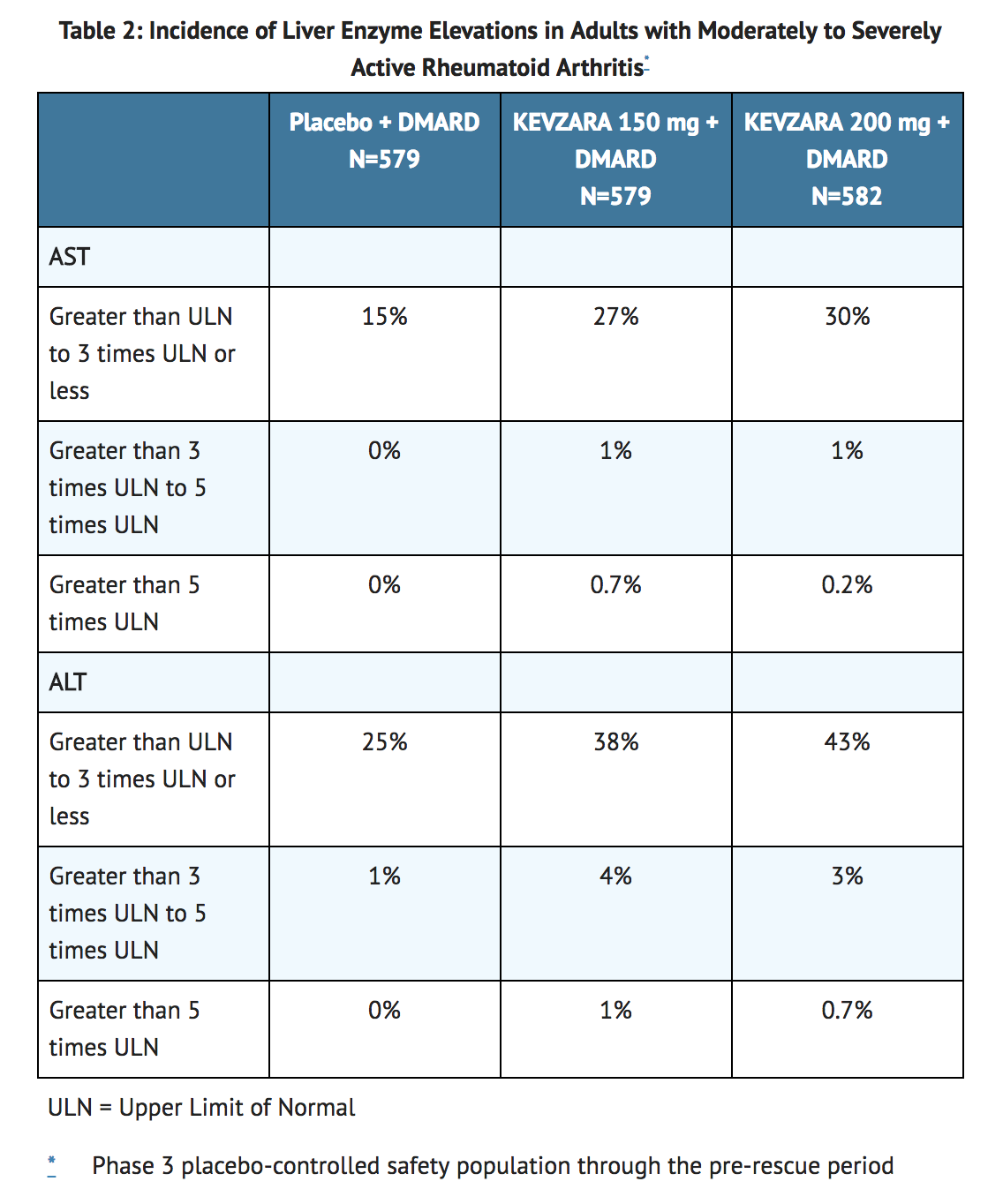
Lipid Abnormalities
- Lipid parameters (LDL, HDL, and triglycerides) were first assessed at 4 weeks following initiation of Sarilumab + DMARDs in the placebo-controlled population. Increases were observed at this time point with no additional increases observed thereafter. Changes in lipid parameters from baseline to Week 4 are summarized below:
- Mean LDL increased by 12 mg/dL in the Sarilumab 150 mg every two weeks + DMARD group and 16 mg/dL in the Sarilumab 200 mg every two weeks + DMARD group.
- Mean triglycerides increased by 20 mg/dL in the Sarilumab 150 mg every two weeks + DMARD group and 27 mg/dL in the Sarilumab 200 mg every two weeks + DMARD group.
- Mean HDL increased by 3 mg/dL in both the Sarilumab 150 mg every two weeks + DMARD and Sarilumab 200 mg every two weeks + DMARD groups.
- In the long-term safety population, the observations in lipid parameters were consistent with what was observed in the placebo-controlled clinical studies.
Malignancies
- In the 52-week placebo-controlled population, 9 malignancies (exposure-adjusted event rate of 1.0 event per 100 patient-years) were diagnosed in patients receiving Sarilumab+ DMARD compared to 4 malignancies in patients in the control group (exposure-adjusted event rate of 1.0 event per 100 patient-years).
- In the long-term safety population, the rate of malignancies was consistent with the rate observed in the placebo-controlled period.
Other Adverse Reactions
- Adverse reactions occurring in 2% or more of patients on Sarilumab + DMARD and greater than those observed in patients on placebo + DMARD are summarized in Table 3.
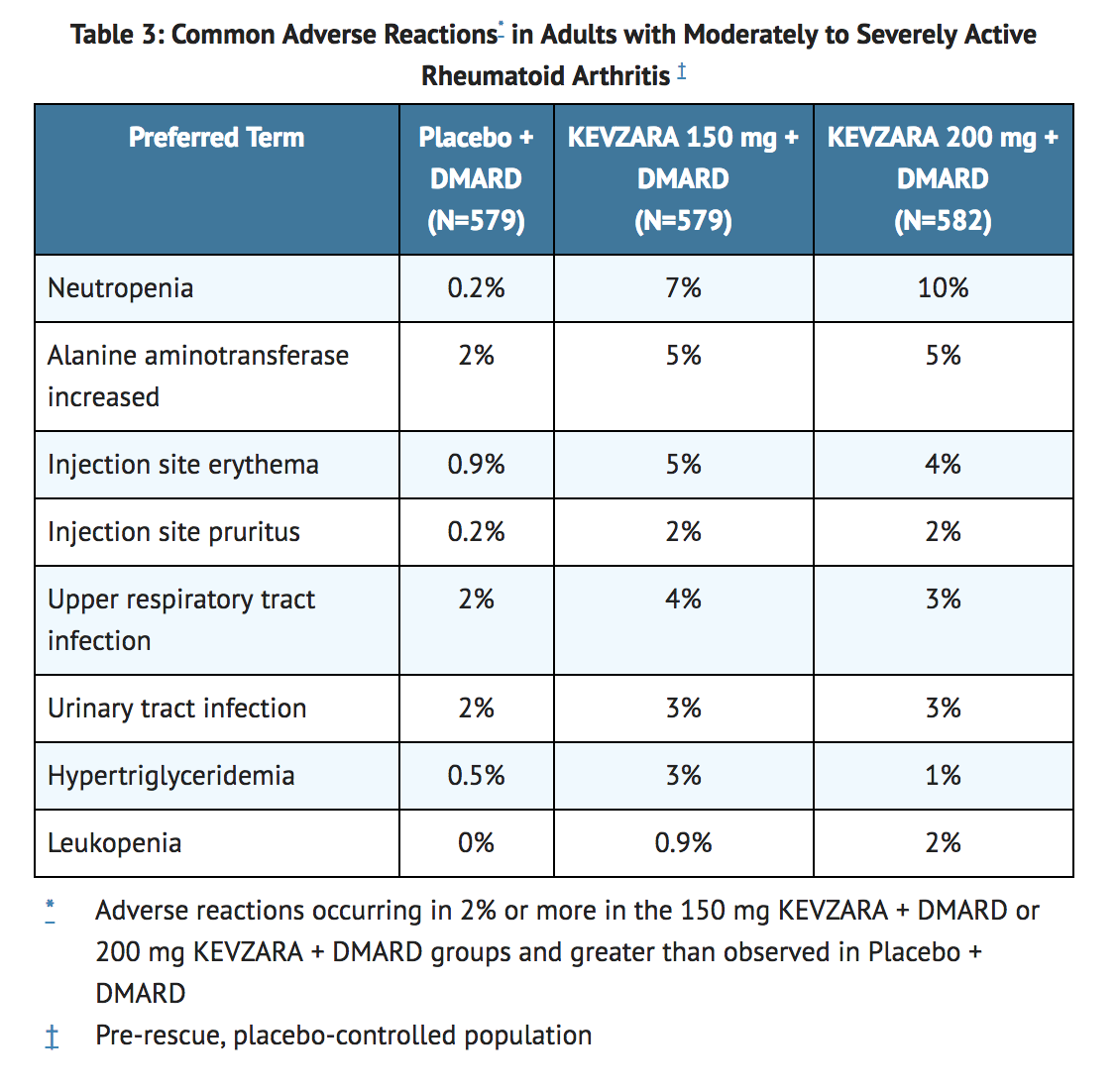
- Medically relevant adverse reactions occurring at an incidence less than 2% in patients with rheumatoid arthritis treated with Sarilumab in controlled studies was oral herpes.
Immunogenicity
- As with all therapeutic proteins, there is potential for immunogenicity. The detection of antibody formation is highly dependent on the sensitivity and specificity of the assay. Additionally, the observed incidence of antibody (including neutralizing antibody) positivity in an assay may be influenced by several factors, including assay methodology, sample handling, timing of sample collection, concomitant medications, and underlying disease. For these reasons, comparison of the incidence of antibodies to Sarilumab in the studies described below with the incidence of antibodies in other studies or to other products may be misleading.
- In the pre-rescue population, 4.0% of patients treated with Sarilumab 200 mg + DMARD, 5.7% of patients treated with Sarilumab 150 mg + DMARD and 1.9% of patients treated with placebo + DMARD, exhibited an anti-drug antibody (ADA) response. Neutralizing antibodies (NAb) were detected in 1.0% of patients on Sarilumab 200 mg + DMARD, 1.6% of patients on Sarilumab 150 mg + DMARD, and 0.2% of patients on placebo + DMARD.
- In patients treated with Sarilumab monotherapy, 9.2% of patients exhibited an ADA response with 6.9% of patients also exhibiting NAbs. Prior to administration of Sarilumab, 2.3% of patients exhibited an ADA response.
- No correlation was observed between ADA development and either loss of efficacy or adverse reactions.
Postmarketing Experience
There is limited information regarding Sarilumab Postmarketing Experience in the drug label.
Drug Interactions
- Use with Other Drugs for Treatment of Rheumatoid Arthritis
- Interactions with CYP450 Substrates
- Live Vaccines
Use with Other Drugs for Treatment of Rheumatoid Arthritis
- Population pharmacokinetic analyses did not detect any effect of methotrexate (MTX) on Sarilumab clearance. Sarilumab has not been investigated in combination with JAK inhibitors or biological DMARDs such as TNF antagonists.
Interactions with CYP450 Substrates
- Various in vitro and limited in vivo human studies have shown that cytokines and cytokine modulators can influence the expression and activity of specific cytochrome P450 (CYP) enzymes and therefore have the potential to alter the pharmacokinetics of concomitantly administered drugs that are substrates of these enzymes. Elevated interleukin-6 (IL-6) concentration may down-regulate CYP activity such as in patients with RA and hence increase drug levels compared to subjects without RA. Blockade of IL-6 signaling by IL-6Rα antagonists such as Sarilumab might reverse the inhibitory effect of IL-6 and restore CYP activity, leading to altered drug concentrations.
- The modulation of IL-6 effect on CYP enzymes by Sarilumab may be clinically relevant for CYP substrates with a narrow therapeutic index, where the dose is individually adjusted. Upon initiation or discontinuation of Sarilumab, in patients being treated with CYP substrate medicinal products, perform therapeutic monitoring of effect (e.g., warfarin) or drug concentration (e.g., theophylline) and adjust the individual dose of the medicinal product as needed.
- Exercise caution when coadministering Sarilumab with CYP3A4 substrate drugs where decrease in effectiveness is undesirable, e.g., oral contraceptives, lovastatin, atorvastatin, etc. The effect of Sarilumab on CYP450 enzyme activity may persist for several weeks after stopping therapy.
Live Vaccines
- Avoid concurrent use of live vaccines during treatment with Sarilumab.
Use in Specific Populations
Pregnancy
Pregnancy Category (FDA): Pregnancy Exposure Registry
- There is a pregnancy exposure registry that monitors pregnancy outcomes in women exposed to Sarilumab during pregnancy. Physicians are encouraged to register patients and pregnant women are encouraged to register themselves by calling 1-877-311-8972.
Risk Summary
- The limited human data with Sarilumab in pregnant women are not sufficient to inform drug-associated risk for major birth defects and miscarriage. Monoclonal antibodies, such as Sarilumab, are actively transported across the placenta during the third trimester of pregnancy and may affect immune response in the in utero exposed infant. From animal data, and consistent with the mechanism of action, levels of IgG, in response to antigen challenge, may be reduced in the fetus/infant of treated mothers. In an animal reproduction study, consisting of a combined embryo-fetal and pre- and postnatal development study with monkeys that received intravenous administration of Sarilumab, there was no evidence of embryotoxicity or fetal malformations with exposures up to approximately 84 times the maximum recommended human dose (MRHD). The literature suggests that inhibition of IL-6 signaling may interfere with cervical ripening and dilatation and myometrial contractile activity leading to potential delays of parturition.
- The estimated background risk of major birth defects and miscarriage for the indicated population is unknown. All pregnancies have a background risk of birth defect, loss, or other adverse outcomes. In the U.S. general population, the estimated background risk of major birth defects and miscarriages in clinically recognized pregnancies is 2 to 4% and 15 to 20%, respectively. Sarilumab should be used in pregnancy only if the potential benefit justifies the potential risk to the fetus.
Clinical Considerations (Fetal/Neonatal Adverse Reactions)
- Monoclonal antibodies are increasingly transported across the placenta as pregnancy progresses, with the largest amount transferred during the third trimester. Risks and benefits should be considered prior to administering live or live-attenuated vaccines to infants exposed to Sarilumab in utero. From the animal data, and consistent with the mechanism of action, levels of IgG, in response to antigen challenge, may be reduced in the fetus/infant of treated mothers.
Data (Animal)
- In a combined embryo-fetal and pre- and postnatal development study, pregnant cynomolgus monkeys received Sarilumab at intravenous doses of 0, 5, 15, or 50 mg/kg/week from confirmation of pregnancy at gestation day (GD) 20, throughout the period of organogenesis (up to approximately GD 50), and continuing to natural birth of infants at around GD 165. Maintenance of pregnancy was not affected at any doses. Sarilumab was not embryotoxic or teratogenic with exposures up to approximately 84 times the MRHD (based on AUC with maternal intravenous doses up to 50 mg/kg/week). Sarilumab had no effect on neonatal growth and development evaluated up to one month after birth. Sarilumab was detected in the serum of neonates up to one month after birth, suggesting that the antibody had crossed the placenta.
- Following antigen challenge, decreased IgG titers attributed to the immunosuppressive action of Sarilumab were evident in studies with older monkeys, with exposures up to approximately 80 times the MRHD (based on AUC with intravenous doses up to 50 mg/kg/week) and juvenile mice treated with an analogous antibody, which binds to murine IL-6Rα to inhibit IL-6 mediated signaling, at subcutaneous doses up to 200 mg/kg/week. These findings suggest the potential for decreased IgG titers, following antigen challenge, in infants of mothers treated with Sarilumab.
- Parturition is associated with significant increases of IL-6 in the cervix and myometrium. The literature suggests that inhibition of IL-6 signaling may interfere with cervical ripening and dilatation and myometrial contractile activity leading to potential delays of parturition. For mice deficient in IL-6 (ll6-/- null mice), parturition was delayed relative to wild-type (ll6+/+) mice. Administration of recombinant IL-6 to ll6-/- null mice restored the normal timing of delivery.
Pregnancy Category (AUS):
There is no Australian Drug Evaluation Committee (ADEC) guidance on usage of Sarilumab in women who are pregnant.
Labor and Delivery
There is no FDA guidance on use of Sarilumab during labor and delivery.
Nursing Mothers
Risk Summary
- No information is available on the presence of Sarilumab in human milk, the effects of the drug on the breastfed infant, or the effects of the drug on milk production. Maternal IgG is present in human milk. If Sarilumab is transferred into human milk, the effects of local exposure in the gastrointestinal tract and potential limited systemic exposure in the infant to Sarilumab are unknown. The lack of clinical data during lactation precludes clear determination of the risk of Sarilumab to an infant during lactation; therefore, the developmental and health benefits of breastfeeding should be considered along with the mother's clinical need for Sarilumab and the potential adverse effects on the breastfed child from Sarilumab or from the underlying maternal condition.
Pediatric Use
- Safety and efficacy of Sarilumab in pediatric patients have not been established.
Geriatic Use
- Of the total number of patients in clinical studies of Sarilumab, 15% were 65 years of age and over, while 1.6% were 75 years and over. In clinical studies, no overall differences in safety and efficacy were observed between older and younger patients. The frequency of serious infection among Sarilumab and placebo-treated patients 65 years of age and older was higher than those under the age of 65. As there is a higher incidence of infections in the elderly population in general, caution should be used when treating the elderly.
Gender
There is no FDA guidance on the use of Sarilumab with respect to specific gender populations.
Race
There is no FDA guidance on the use of Sarilumab with respect to specific racial populations.
Renal Impairment
- No dose adjustment is required in patients with mild to moderate renal impairment. Sarilumab has not been studied in patients with severe renal impairment.
Hepatic Impairment
- The safety and efficacy of Sarilumab have not been studied in patients with hepatic impairment, including patients with positive HBV or HCV serology.
Females of Reproductive Potential and Males
There is no FDA guidance on the use of Sarilumab in women of reproductive potentials and males.
Immunocompromised Patients
There is no FDA guidance one the use of Sarilumab in patients who are immunocompromised.
Administration and Monitoring
Administration
Subcutaneous
- Allow to sit at room temperature for 30 minutes prior to administration or 60 minutes if using a pre-filled pen; do not warm any other way.
- Rotate injection sites; do not inject where skin is tender, damaged, bruised, or scarred.
- Inject full amount of pre-filled syringe or pen.
- Missed dose: If 3 days or less since missed dose, take as soon as possible; take next dose at regularly scheduled time.
Monitoring
- Improvement in the signs or symptoms of rheumatoid arthritis may indicate efficacy.
- Neutrophils and platelets: 4 to 8 weeks after treatment initiation and approximately every 3 months thereafter.
- ALT and AST levels: 4 to 8 weeks after treatment initiation and approximately every 3 months thereafter; other liver function tests if clinically indicated.
- Lipid parameters: Approximately 4 to 8 weeks after treatment initiation, and at 6 month intervals thereafter.
- Latent TB: Prior to initiation.
- Active TB: Monitor all patients for active TB during treatment, even if initial latent TB test was negative.
- Signs and symptoms of infection: During and after therapy.
IV Compatibility
There is limited information regarding the compatibility of Sarilumab and IV administrations.
Overdosage
There is limited information regarding Sarilumab overdosage. If you suspect drug poisoning or overdose, please contact the National Poison Help hotline (1-800-222-1222) immediately.
Pharmacology
Sarilumab?
| |
| Therapeutic monoclonal antibody | |
| Source | u |
| Target | IL-6R |
| Identifiers | |
| CAS number | |
| ATC code | L04 |
| PubChem | ? |
| Chemical data | |
| Formula | Template:OrganicBox atomTemplate:OrganicBox atomTemplate:OrganicBoxTemplate:OrganicBoxTemplate:OrganicBoxTemplate:OrganicBoxTemplate:OrganicBoxTemplate:OrganicBoxTemplate:OrganicBoxTemplate:OrganicBoxTemplate:OrganicBoxTemplate:OrganicBoxTemplate:OrganicBoxTemplate:OrganicBox atomTemplate:OrganicBoxTemplate:OrganicBox atomTemplate:OrganicBoxTemplate:OrganicBoxTemplate:OrganicBox atomTemplate:OrganicBoxTemplate:OrganicBoxTemplate:OrganicBoxTemplate:OrganicBox |
| Mol. mass | 144.13 kg/mol |
| Pharmacokinetic data | |
| Bioavailability | 80% |
| Metabolism | likely proteases |
| Half life | 21 days (steady-state, estimated) |
| Excretion | ? |
| Therapeutic considerations | |
| Pregnancy cat. |
? |
| Legal status |
[[Prescription drug|Template:Unicode-only]](US) |
| Routes | Subcutaneous injection |
Mechanism of Action
- Sarilumab binds to both soluble and membrane-bound IL-6 receptors (sIL-6R and mIL-6R), and has been shown to inhibit IL-6-mediated signaling through these receptors. IL-6 is a pleiotropic pro-inflammatory cytokine produced by a variety of cell types including T- and B-cells, lymphocytes, monocytes, and fibroblasts. IL-6 has been shown to be involved in diverse physiological processes such as T-cell activation, induction of immunoglobulin secretion, initiation of hepatic acute phase protein synthesis, and stimulation of hematopoietic precursor cell proliferation and differentiation. IL-6 is also produced by synovial and endothelial cells leading to local production of IL-6 in joints affected by inflammatory processes such as rheumatoid arthritis.
Structure
There is limited information regarding Sarilumab Structure in the drug label.
Pharmacodynamics
- Following single-dose subcutaneous administration of Sarilumab 200-mg and 150-mg in patients with RA, rapid reduction of CRP levels was observed. Levels were reduced to normal within 2 weeks after treatment initiation. Following single-dose Sarilumab administration, in patients with RA, absolute neutrophil counts decreased to the nadir between 3 to 4 days and thereafter recovered towards baseline. Treatment with Sarilumab resulted in decreases in fibrinogen and serum amyloid A, and increases in hemoglobin and serum albumin.
Pharmacokinetics
Absorption
- The pharmacokinetics of Sarilumab were characterized in 1770 patients with rheumatoid arthritis (RA) treated with Sarilumab which included 631 patients treated with 150 mg and 682 patients treated with 200 mg doses by subcutaneous injection every two weeks for up to 52 weeks. The median tmax was observed in 2 to 4 days.
- At steady state, exposure over the dosing interval measured by area under curve (AUC) increased 2-fold with an increase in dose from 150 to 200 mg every two weeks. Steady state was reached in 14 to 16 weeks with a 2- to 3-fold accumulation compared to single dose exposure.
- For the 150 mg every two weeks dose regimen, the estimated mean (± SD) steady-state AUC, Cmin and Cmax of Sarilumab were 202 ± 120 mg.day/L, 6.35 ± 7.54 mg/L, and 20.0 ± 9.20 mg/L, respectively.
- For the 200 mg every two weeks dose regimen, the estimated mean (± SD) steady-state AUC, Cmin and Cmax of Sarilumab were 395 ± 207 mg.day/L, 16.5 ± 14.1 mg/L, and 35.6 ± 15.2 mg/L, respectively.
Distribution
- In patients with RA, the apparent volume of distribution at steady state was 7.3 L.
Elimination
- Sarilumab is eliminated by parallel linear and non-linear pathways. At higher concentrations, the elimination is predominantly through the linear, non-saturable proteolytic pathway, while at lower concentrations, non-linear saturable target-mediated elimination predominates. The half-life of Sarilumab is concentration-dependent. At 200 mg every 2 weeks, the concentration-dependent half-life is up to 10 days in patients with RA at steady state. At 150 mg every 2 weeks, the concentration-dependent half-life is up to 8 days in patients with RA at steady state.
- After the last steady state dose of 150 mg and 200 mg Sarilumab, the median times to non-detectable concentration are 28 and 43 days, respectively.
- Population pharmacokinetic analyses in patients with RA revealed that there was a trend toward higher apparent clearance of Sarilumab in the presence of anti-Sarilumab antibodies.
Metabolism
- The metabolic pathway of Sarilumab has not been characterized. As a monoclonal antibody Sarilumab is expected to be degraded into small peptides and amino acids via catabolic pathways in the same manner as endogenous IgG.
Excretion
- Monoclonal antibodies, including Sarilumab, are not eliminated via renal or hepatic pathways.
Specific Populations
- Population pharmacokinetic analyses in adult patients with rheumatoid arthritis showed that age, gender and race did not meaningfully influence the pharmacokinetics of Sarilumab. Although body weight influenced the pharmacokinetics of Sarilumab, no dose adjustments are recommended for any of these demographics.
Hepatic impairment
- No formal study of the effect of hepatic impairment on the pharmacokinetics of Sarilumab was conducted.
Renal impairment
- No formal study of the effect of renal impairment on the pharmacokinetics of Sarilumab was conducted. Based on population pharmacokinetic analysis of data from 1770 patients with RA, including patients with mild (creatinine clearance (CLcr): 60 to 90 mL/min; N=471 at baseline) or moderate (CLcr: 30 to 60 mL/min; N=74 at baseline) renal impairment, CLcr was correlated with Sarilumab exposure. However, the effect of CLcr on exposure is not sufficient to warrant a dose adjustment. Patients with severe renal impairment were not studied.
Drug-Drug Interactions
CYP450 substrates
- Simvastatin is a CYP3A4 and OATP1B1 substrate. In 17 patients with RA, one week following a single 200-mg subcutaneous administration of Sarilumab, exposure of simvastatin and simvastatin acid decreased by 45% and 36%, respectively.
Nonclinical Toxicology
Carcinogenesis, Mutagenesis, Impairment of Fertility
- No long-term animal studies have been performed to establish the carcinogenicity potential of Sarilumab. Literature indicates that the IL-6 pathway can mediate anti-tumor responses by promoting increased immune cell surveillance of the tumor microenvironment. However, available published evidence also supports that IL-6 signaling through the IL-6 receptor may be involved in pathways that lead to tumorigenesis. The malignancy risk in humans from an antibody that disrupts signaling through the IL-6 receptor, such as Sarilumab, is presently unknown.
- Fertility and reproductive performance were unaffected in male and female mice treated with an analogous antibody, which binds to murine IL-6Rα to inhibit IL-6 mediated signaling, at subcutaneous doses of 10, 25, and 100 mg/kg twice per week.
Clinical Studies
Design of Clinical Studies in Adults with Moderately to Severely Active RA
- The efficacy and safety of Sarilumab were assessed in two randomized, double-blind, placebo-controlled multicenter studies (Study 1 and Study 2) in patients older than 18 years with moderately to severely active rheumatoid arthritis (RA) diagnosed according to American College of Rheumatology (ACR) criteria. Patients had at least 8 tender and 6 swollen joints at baseline.
- Study 1 evaluated 1197 patients with moderately to severely active rheumatoid arthritis who had inadequate clinical response to methotrexate (MTX). Patients received subcutaneous Sarilumab 200 mg, Sarilumab 150 mg, or placebo every two weeks with concomitant MTX. After Week 16 in Study 1, patients with an inadequate response could have been rescued with Sarilumab 200 mg every two weeks.
- Study 2 evaluated 546 patients with moderately to severely active rheumatoid arthritis who had an inadequate clinical response or were intolerant to one or more TNF-α antagonists. Patients received subcutaneous Sarilumab 200 mg, Sarilumab 150 mg, or placebo every two weeks with concomitant conventional DMARDs (MTX, sulfasalazine, leflunomide, and/or hydroxychloroquine). After Week 12 in Study 2, patients with an inadequate response could have been rescued with Sarilumab 200 mg every two weeks.
- In Studies 1 and 2, the primary endpoint was the proportion of patients who achieved an ACR20 response at Week 24. Other key endpoints evaluated included change from baseline in HAQ-DI at Week 16 in Study 1 and at Week 12 in Study 2, and change from baseline in van der Heijde-modified Total Sharp Score (mTSS) at Week 52 in Study 1.
Clinical Response
- The percentages of Sarilumab every two weeks + MTX/DMARD-treated patients achieving ACR20, ACR50 and ACR70 responses in Studies 1 and 2 are shown Table 4. In both studies, patients treated with either 200 mg or 150 mg of Sarilumab every two weeks + MTX/DMARD had higher ACR20, ACR50, and ACR70 response rates versus placebo + MTX/DMARD-treated patients at Week 24.
- In Studies 1 and 2, a greater proportion of patients treated with Sarilumab 200 mg or 150 mg every two weeks plus MTX/DMARD achieved a low level of disease activity as measured by a Disease Activity Score 28-C-Reactive Protein (DAS28-CRP) <2.6 compared with placebo + MTX/DMARD at the end of the studies (Table 4). In Study 1, the proportion of patients achieving DAS28-CRP <2.6 who had at least 3 or more active joints at the end of Week 24 was 33.1%, 37.8% and 20%, in the Sarilumab 200 mg + MTX/DMARD arm, Sarilumab 150 mg + MTX/DMARD arm, and placebo arm respectively.

- The percent ACR20 response by visit in Study 1 is shown in Figure 1. A similar response curve was observed in Study 2.
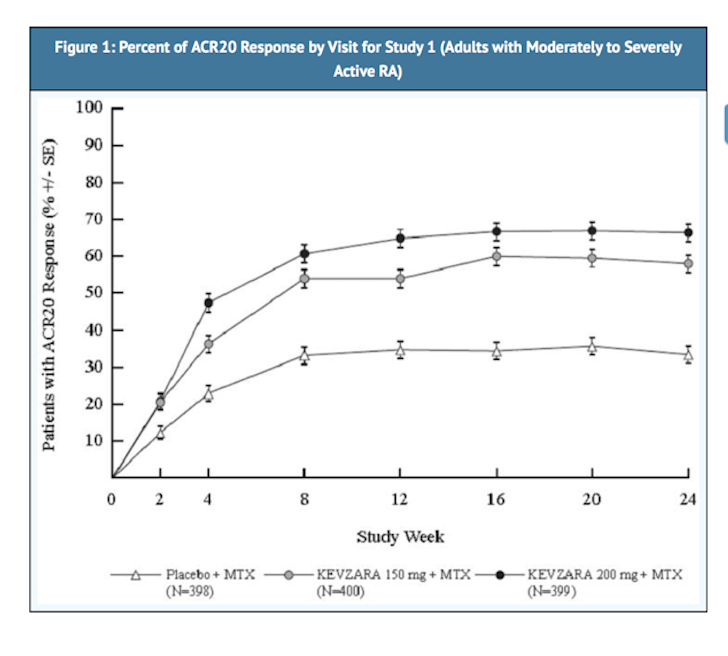
- The results of the components of the ACR response criteria at Week 12 for Studies 1 and 2 are shown in Table 5.
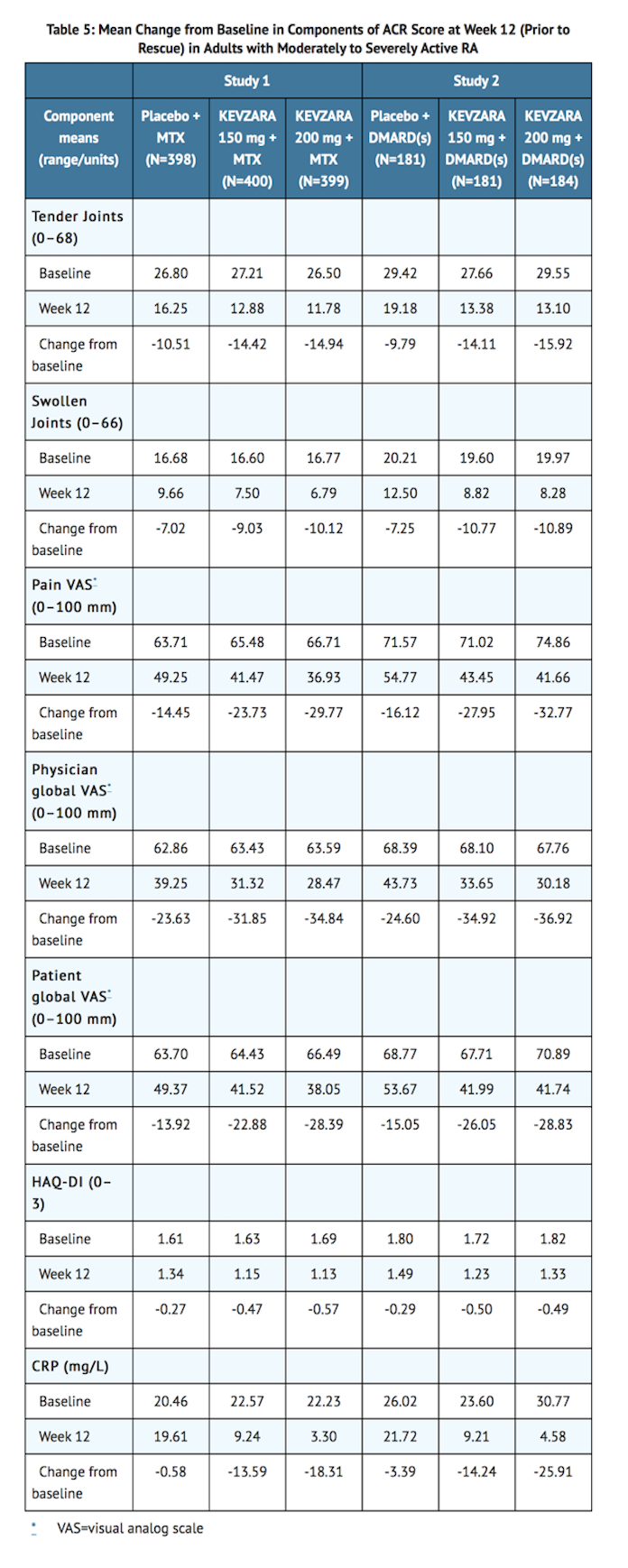
Radiographic Response
- In Study 1, structural joint damage was assessed radiographically and expressed as the van der Heijde-modified Total Sharp Score (mTSS) and its components, the erosion score and joint space narrowing score. Radiographs of hands and feet were obtained at baseline, 24 weeks, and 52 weeks and scored independently by at least two well-trained readers who were blinded to treatment group and visit number.
- Both doses of Sarilumab + MTX were superior to placebo + MTX in the change from baseline in mTSS over 52 weeks. Less progression of both erosion and joint space narrowing scores over 52 weeks was reported in the Sarilumab + MTX treatment groups compared to the placebo + MTX group.
- Treatment with Sarilumab + MTX was associated with significantly less radiographic progression of structural damage as compared with placebo + MTX. At Week 52, 55.6% of patients receiving Sarilumab 200 mg + MTX and 47.8% of patients receiving Sarilumab 150 mg + MTX had no progression of structural damage (as defined by a change in the Total Sharp Score of zero or less) compared with 38.7% of patients receiving placebo.
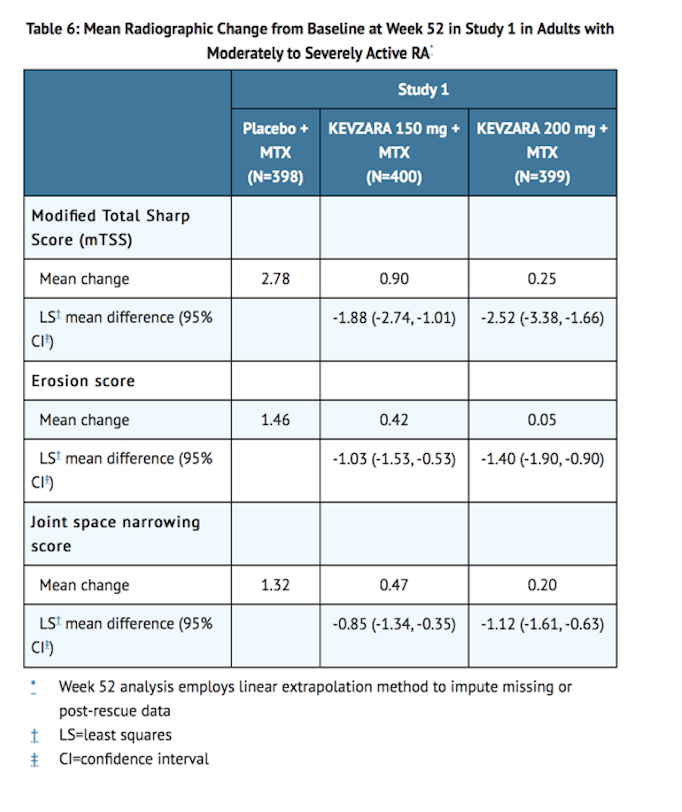
Physical Function Response
- In Studies 1 and 2, physical function and disability were assessed by the Health Assessment Questionnaire Disability Index (HAQ-DI). Patients receiving Sarilumab 200 mg every two weeks + MTX/DMARD and Sarilumab 150 mg every two weeks + MTX/DMARD demonstrated greater improvement from baseline in physical function compared to placebo + MTX/DMARD at Week 16 and Week 12 in Studies 1 and 2, respectively (Table 7).
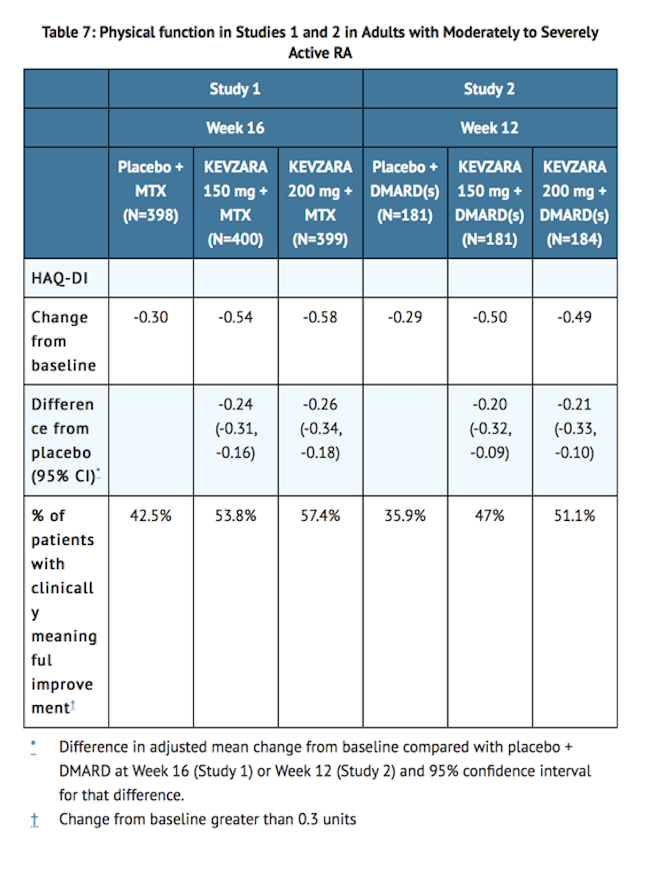
Other Health Related Outcomes
- General health status was assessed by the Short Form health survey (SF-36) in Studies 1 and 2. Patients receiving Sarilumab 200 mg every two weeks + MTX/DMARD demonstrated greater improvement from baseline compared to placebo + MTX/DMARD in the physical component summary (PCS) at Week 24, but there was no evidence of a difference between the treatment groups in the mental component summary (MCS) at Week 24. Patients receiving Sarilumab 200 mg + MTX/DMARD reported greater improvement relative to placebo in the domains of Physical Functioning, Role Physical, Bodily Pain, General Health Perception, Vitality, Social Functioning and Mental Health, but not in the Role Emotional domain.
How Supplied
- Sarilumab injection is supplied as a colorless to pale yellow solution in a single-dose pre-filled syringes and single-dose pre-filled pens.
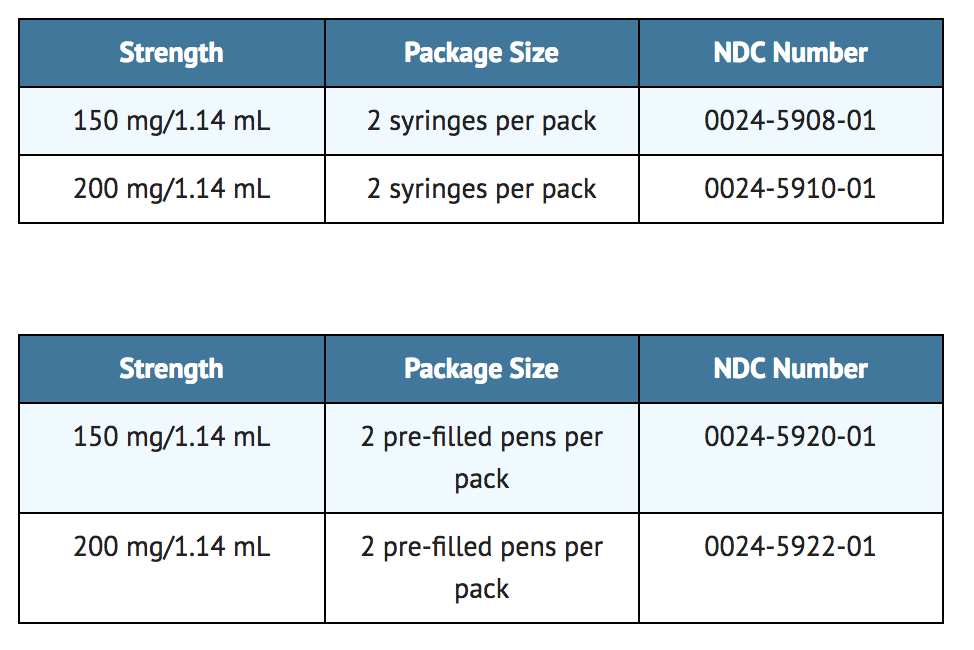
Storage
- Refrigerate at 36°F to 46°F (2°C to 8°C) in original carton to protect from light. Do not freeze. Do not shake.
- If needed, patients/caregivers may store Sarilumab at room temperature up to 77°F (25°C) up to 14 days in the outer carton. Do not store above 77°F (25°C). After removal from the refrigerator, use Sarilumab within 14 days or discard.
Images
Drug Images
{{#ask: Page Name::Sarilumab |?Pill Name |?Drug Name |?Pill Ingred |?Pill Imprint |?Pill Dosage |?Pill Color |?Pill Shape |?Pill Size (mm) |?Pill Scoring |?NDC |?Drug Author |format=template |template=DrugPageImages |mainlabel=- |sort=Pill Name }}
Package and Label Display Panel
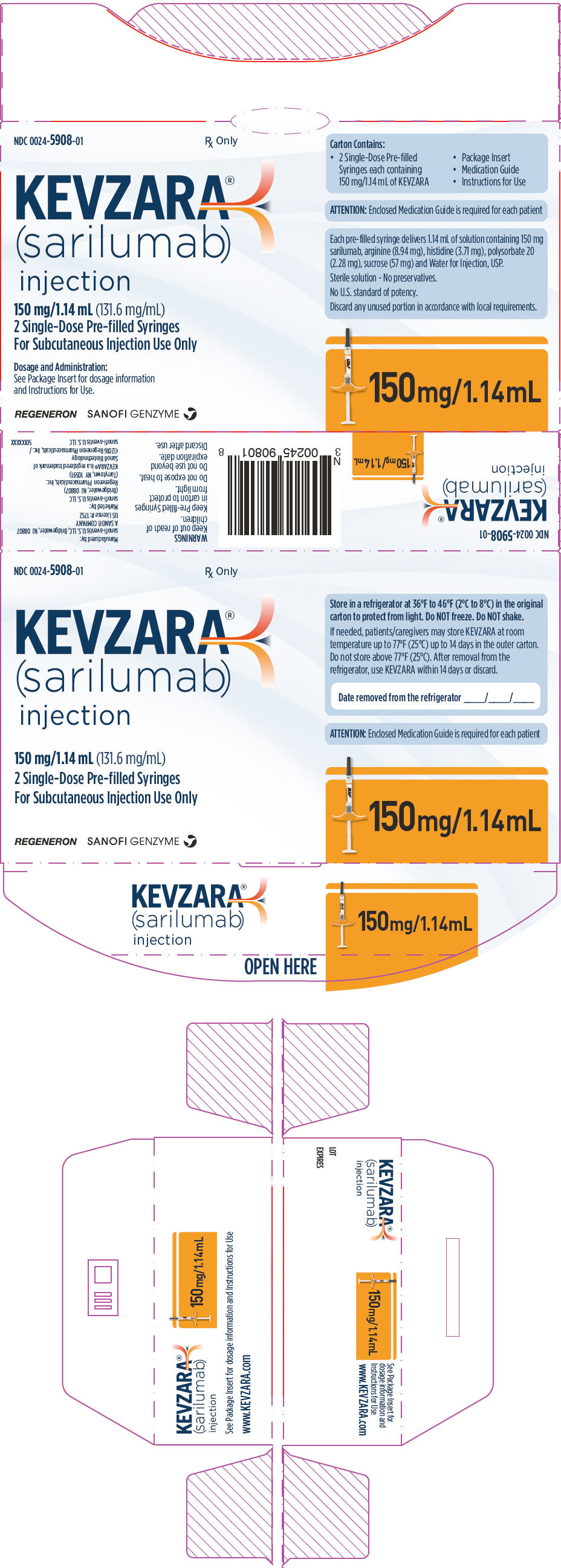
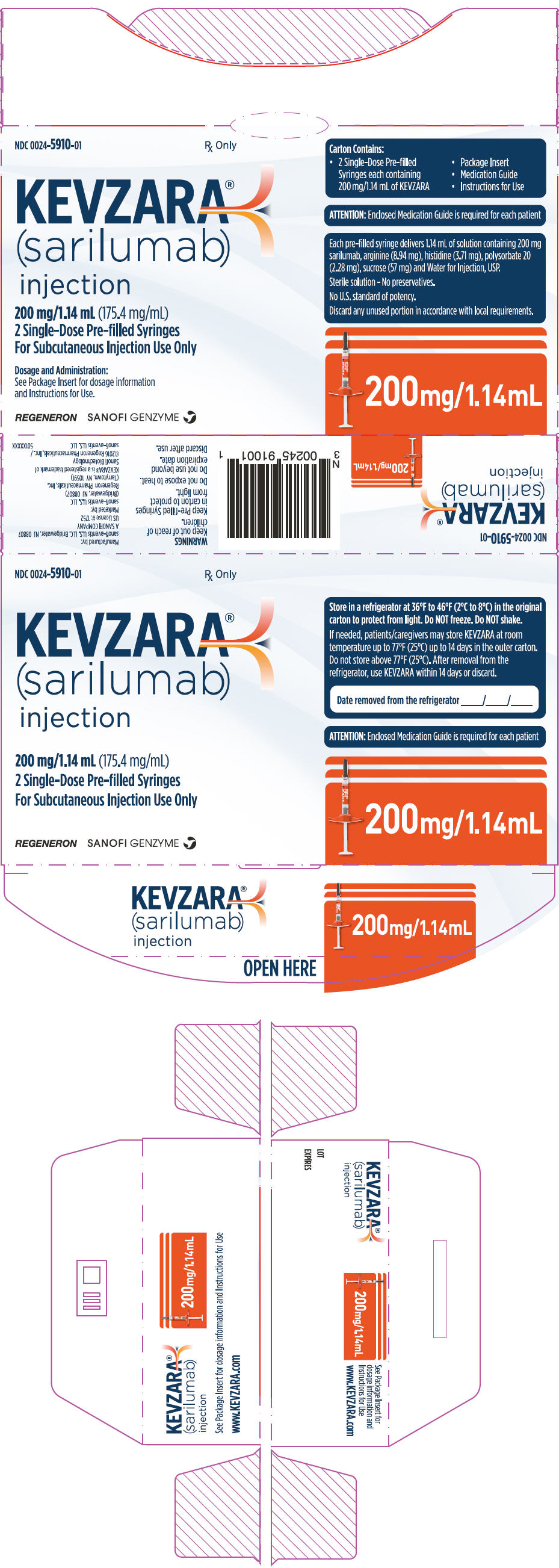
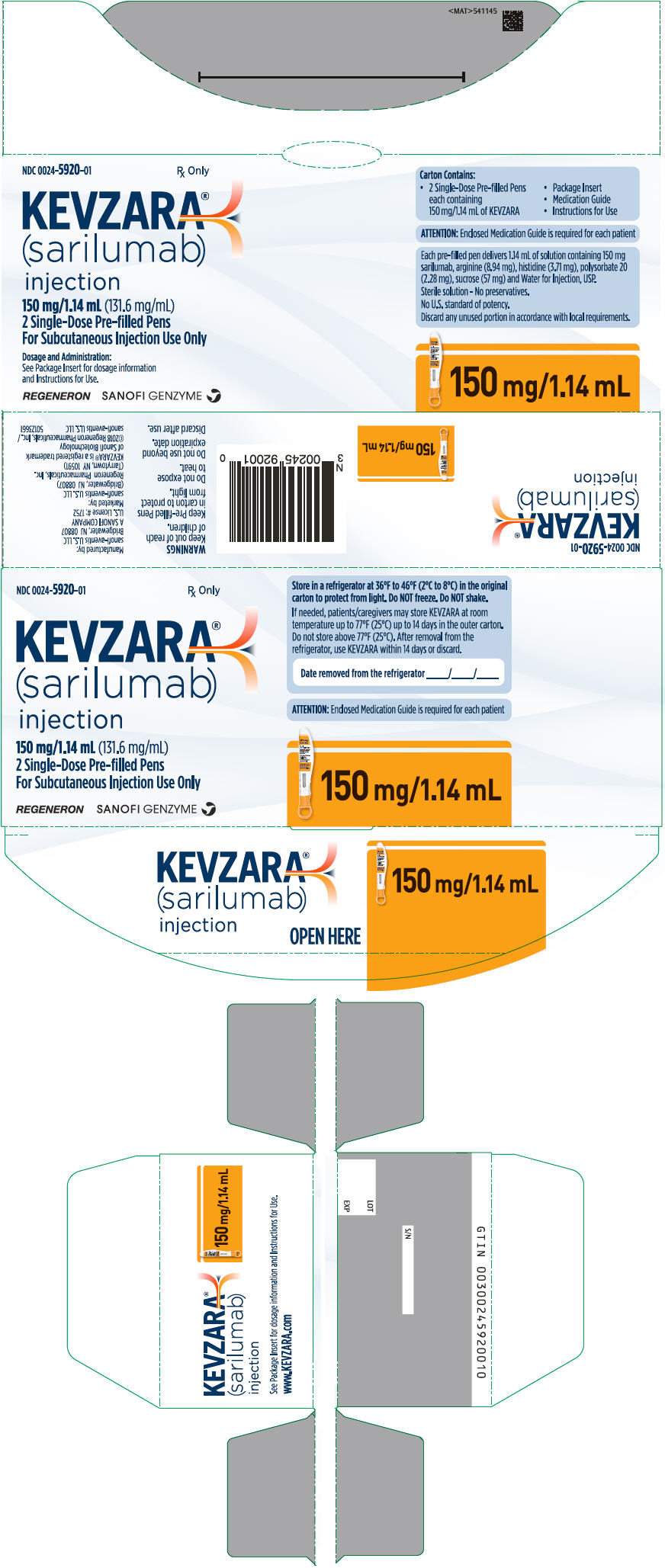
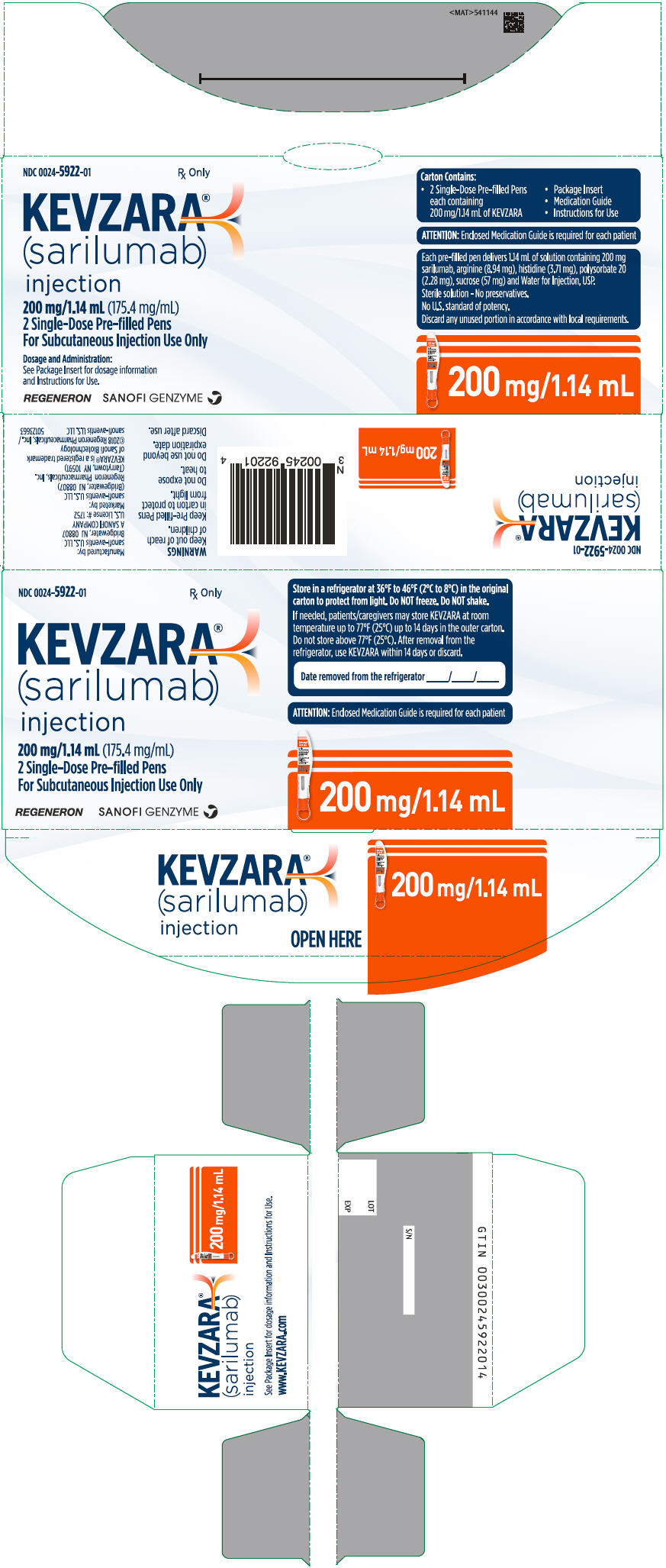
{{#ask: Label Page::Sarilumab |?Label Name |format=template |template=DrugLabelImages |mainlabel=- |sort=Label Page }}
Patient Counseling Information
Infections
- Inform patients that Sarilumab may lower their resistance to infections. Instruct patients to contact their physician immediately when symptoms suggesting infection appear, to ensure rapid evaluation and appropriate treatment.
Gastrointestinal Perforation
- Inform patients that some patients, particularly those also taking NSAIDS, and/or steroids, have had tears (perforations) of the stomach or intestines. Inform patients that gastrointestinal perforations have been reported in Sarilumab-treated patients in clinical studies, primarily as a complication of diverticulitis. Instruct patients to contact their physician immediately when symptoms of severe, persistent abdominal pain appear to ensure rapid evaluation and appropriate treatment.
Hypersensitivity and Serious Allergic Reaction
- Assess patient suitability for home use for SC injection. Inform patients that some patients who have been treated with Sarilumab have developed serious allergic reactions. Advise patients to seek immediate medical attention if they experience any symptom of serious allergic reactions.
Pregnancy Registry
- There is a pregnancy exposure registry that monitors pregnancy outcomes in women exposed to Sarilumab during pregnancy. Encourage participation in the registry.
Instruction on Injection Technique
- Instruct patients and caregivers to read the Instructions for Use before the patient starts using Sarilumab, and each time the patient gets a refill as there may be new information they need to know.
- Provide guidance to patients and caregivers on proper subcutaneous injection technique, including aseptic technique, and how to use the pre-filled syringe or pre-filled pen correctly.
- The pre-filled syringe or pre-filled pen should be left at room temperature for 30 minutes or 60 minutes respectively prior to use. The syringe or pen should be used within 14 days after being taken out of the refrigerator. A puncture-resistant container should be used to dispose the used pre-filled syringes or pre-filled pens and should be kept out of the reach of children. Instruct patients or caregivers in the technique as well as proper pre-filled syringe or pre-filled pen disposal, and caution against reuse of these items.

Precautions with Alcohol
Alcohol-Sarilumab interaction has not been established. Talk to your doctor regarding the effects of taking alcohol with this medication.
Brand Names
- Kevzara
Look-Alike Drug Names
There is limited information regarding Sarilumab Look-Alike Drug Names in the drug label.
Drug Shortage Status
Drug Shortage
Price
References
The contents of this FDA label are provided by the National Library of Medicine.